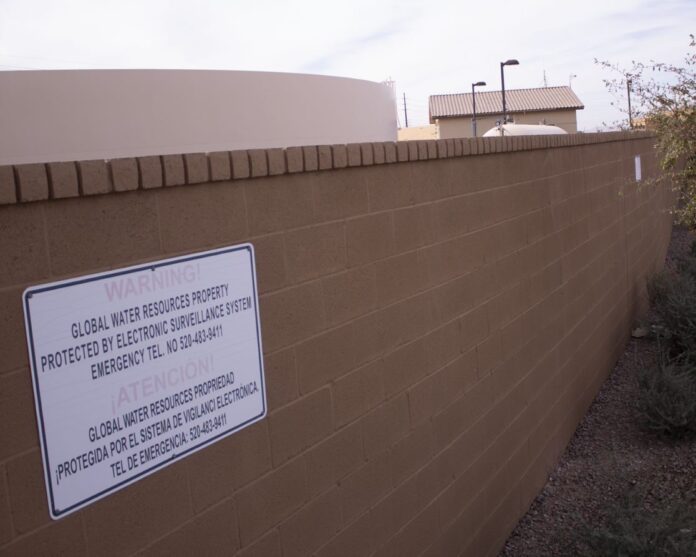
With all the growth taking place in Maricopa, and thousands more homes on the drawing board, you must wonder if the city can keep up. But the leaders of area utilities say they have the capability and funding to match the city’s explosive growth.
The first requirement for new developments is roads. City manager Rick Horst said they will come as warranted because developers pay the tab for all the streets within a given development. The city may pay for a base level road to get to the development, but those who will benefit from those roads pay for them.
He uses the example of Bowlin Road directly south of city hall. The city improved the alignment when city hall was built, even though there was no development in the area. But Horst said there was a good reason for that.
“That road right now is just chip sealed for public access but mostly it’s for public safety, so police and fire have faster access,” he said. “But that is not going to be the final road between White and Parker and Tortosa. Ultimately the developers will come in and they’ll widen it and put in the bike lanes, and the gutters, sidewalks, street lights, landscaping and more. We want the developers to pay for it, not the taxpayers.”
Horst discussed the 20,000-or-so homes planned for the southern part of Maricopa, saying that while it may seem like a daunting task to provide that much infrastructure, it all will be done as growth requires it.
“If someone builds south of the city, they’ll obviously build all the roads and bridges within that project,” Horst said. “But the connectors that get them from there to the city have to be accommodated, too. That could be half-road improvements (out to the center line of the road). It’s all about fairness and equity. But at the same time, you have to build enough for people to get through safely.
“So, it’s very rare that the taxpayer pays for new growth,” he added. “New growth pays for new growth. And the developers, of course, recoup their costs by passing on the price to the homeowners, the people who ultimately purchase the new homes. But the city does not charge a fee for developer-required infrastructure — we just demand that they build the infrastructure.”
Other infrastructure is not paid for by developers. Electricity, water, telephone and internet are paid for through private investment. The city’s primary utility providers — Electrical District #3, Global Water and Orbitel Communications — all say they are prepared and well-positioned to meet the city’s growth needs.
Brian Yerges, general manager of ED3 in Maricopa, said his company is already planning for that growth. The company will invest $50 million over the next five years to improve and expand its local distribution system.
But they too get help from developers.
“Developers are responsible for upfront infrastructure costs,” he said. “So, when a new subdivision is built, most of the time they are fronting the capital upfront to build out the electric within the development.”
He added that while the developers pay for the initial infrastructure, ED3 must pay for maintenance and upgrades as needed. He also said that if a major commercial development or factory comes to town that also would fall to the developer.
“If a large commercial development came, and a large transformer at a substation is purely for that commercial project, we wouldn’t ask ratepayers to pay for that, we expect the commercial developer to pay for that. If it’s a transformer being shared by all kinds of customers, then we would pay for it. It’s a case-by-case scenario depending on who the user is.”
A concern for many residents of Maricopa is that massive growth will overtax the available water supply. In a desert suffering through unprecedented drought, it is a legitimate concern. But not necessarily a valid one, according to Jon Corwin, vice president and general manager of Global Water, the city’s water utility.
According to Corwin, Global Water has more than enough water to accommodate the growth projected for the area over the next decade.
He noted that any developer that wants to build a community is required to provide the state with a certificate of assured water supply, which shows that developer has a contract with a water provider for the amount required for that community for 100 years. Those looking to develop in Maricopa get that certificate through Global Water. And Corwin said they have plenty to give.
“As a utility we’re managing that process, and we have what is called a designation of assured water supply,” he said. “Currently, we have approximately 23,000 acre feet of allotment in our designation of assured water supply, and we only use about 7,000 acre feet of that currently. So, the city could triple in size in terms of water usage and we would still have enough water to meet that need.”
All of Global Water’s supply comes from groundwater. So, the drought conditions that have dramatically lowered water levels in Lake Mead do not affect Global or its customers in Maricopa, as they do not use any Central Arizona Project allocations in the city.
Although Corwin said there is plenty of supply for the future, but getting water to all those new homes and then treating the wastewater is another story. Global Water has an answer that is 15 years in the making.
Prior to the Great Recession that began in 2007, Global built its Southwest Plant near Papago and Green roads. It was designed when much of today’s growth initially began to emerge, although it was stalled due to the economic downturn. And so was the Southwest Plant. But it is emerging from mothballs and being recommissioned to meet the future need in the southern part of Maricopa.
“Our Southwest Plant is going to take everything south of Papago Road and west of 347 and potentially west of Ralston Road,” Corwin said. “We believe utilities should be planned on a regional scale, and Global Water has planned for many years regionally to prepare for this growth.”
Corwin said Global has been working with property owners for years to develop agreements to allow easements through landowners’ properties so it can run water distribution mains and other infrastructure to serve both the landowners and neighboring properties.
“Certainly, there would be a lot of infrastructure that would have to go in the ground, but a lot of that planning has already been done,” he said. “There still is obviously the detailed engineering that would need to be done but the planning is the critical element. We need to be in lock step with the city and developers, and the process can take some time, but it’s very important to us that we’re not holding up that development.”
John Schurz, the president and general manager of Orbitel Communications, the city’s primary phone, cable and internet provider, agreed with Corwin on the importance of planning.
“I commend the community leaders and builders who are doing a great job setting the tone for growth. They are great for the city,” he said. “We are doing a lot of planning with all the new building going on. Our plan is to provide fiber optic service to all of these new-build homes. That will allow for speeds of up to 1 GB, which is about five times the current peak speeds.
Schurz said Orbitel offered speeds of about 25 MB a decade ago, and are now up to 200 GB, with plans to launch 1 GB service to all Maricopa customers next year.
“All these investments and improvements are done with private capital,” he said. “It’s a sizeable commitment. But because we have seen that the growth is there and the need is there, the answer is yes, we want to make that investment. We want to make sure we stay ahead of the growth curve, and we also want to make sure we stay ahead of supply chain.
“Our company over the past decade has put in about $20 million in private capital,” he continued. “We’re expecting a similar growth rate over next decade, so you can see what kind of investment we’ll be making in the community.”
Horst said the city is constantly evaluating where it stands in terms of infrastructure and what it needs to do to stay ahead of the curve. The city’s Infrastructure Improvements Plan (IIP) lists the projects it anticipates will need to be built based on growth, and those plans are ever-changing.
“Typically, those are done every five years but in a vast growth city like ours we find we have to do it more often, otherwise we’d get behind,” he said. “We actually adopted our IIP a year and a half ago and we’re already in the process of re-doing three of the elements now (transportation, parks and recreation, and fire). And of course, that plan is reviewed very closely by developers because they don’t want to pay any more than they have to.”
Horst is certain regional growth will continue, and Maricopa will be right in the center of it.
“Maricopa is the largest city in Pinal County, which is right in the center of Pima and Maricopa counties,” he said. “This is going to be the growth county for the decades to come and we have to be ready for it, and we will.”
This story was first published in the December edition of InMaricopa magazine.

![MHS G.O.A.T. a ‘rookie sleeper’ in NFL draft Arizona Wildcats wide receiver Jacob Cowing speaks to the press after a practice Aug. 11, 2023. [Bryan Mordt]](https://www.inmaricopa.com/wp-content/uploads/2024/04/cowing-overlay-3-218x150.png)




![Maricopa’s ‘TikTok Rizz Party,’ explained One of several flyers for a "TikTok rizz party" is taped to a door in the Maricopa Business Center along Honeycutt Road on April 23, 2024. [Monica D. Spencer]](https://www.inmaricopa.com/wp-content/uploads/2024/04/spencer-042324-tiktok-rizz-party-flyer-web-218x150.jpg)





![Alleged car thief released without charges Phoenix police stop a stolen vehicle on April 20, 2024. [Facebook]](https://www.inmaricopa.com/wp-content/uploads/2024/04/IMG_5040-218x150.jpg)

![MHS G.O.A.T. a ‘rookie sleeper’ in NFL draft Arizona Wildcats wide receiver Jacob Cowing speaks to the press after a practice Aug. 11, 2023. [Bryan Mordt]](https://www.inmaricopa.com/wp-content/uploads/2024/04/cowing-overlay-3-100x70.png)


